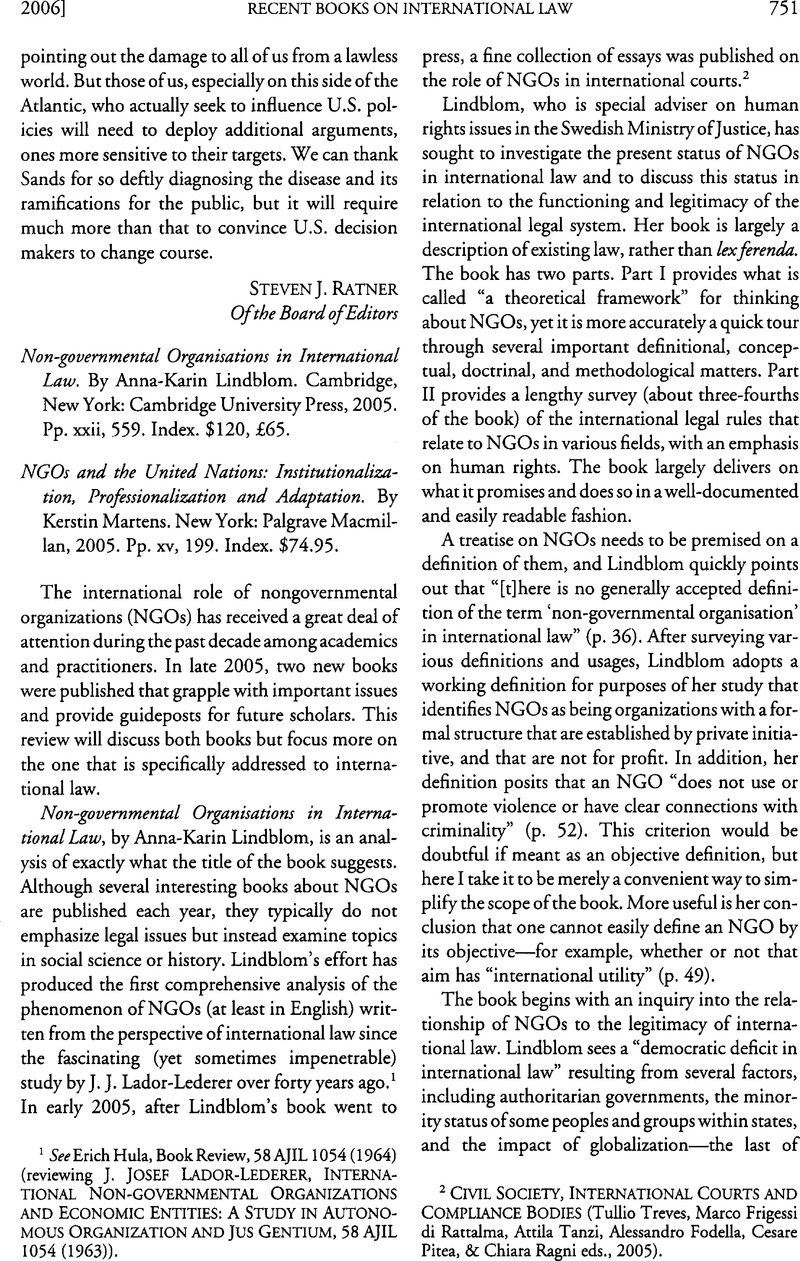No CrossRef data available.
Published online by Cambridge University Press: 27 February 2017

1 See Erich, Hula, Book Review, 58 AJIL 1054 (1964)Google Scholar (reviewing Josef Lador–Lederer, J., International Non–Governmental Organizations And Economic Entities: A Study In Autonomous Organization And Jus Gentium, 58 AJIL 1054 (1963)Google Scholar).
2 Civil Society, International Courts And Compliance Bodies (Tullio Treves, Marco Frigessi di Rattalma, Attila Tanzi, Alessandro Fodella, Cesare Pitea, & Chiara Ragni eds., 2005).
3 Susan, Marks, The Riddle of All Constitutions 119 (2000)Google Scholar. Marks says that this principle “would help justify the efforts of non–governmental organizations to take up a central role in the framing of international law norms.” Id. at 113.
4 See Reparations for Injuries Suffered in the Service of the United Nations, 1949 ICJ Rep. 174, 179–80 (Apr. 11)Google Scholar.
5 See, e.g., Arthur, C. Breycha–Vauthier & Michael, Potulicki, The Order of St. John in International Law: A Forerunner of the Red Cross, 48 AJIL 554 (1954)Google Scholar.
6 Lindblom notes that “the ICRC does not consider itself to be an NGO” (p. 205). A recent study concluded that the ICRC’s legal status “is a very special one, which cannot be fitted into existing legal categories: indeed, it is neither an intergovernmental organization nor a nongovernmental organization (NGO).” Jean Phillippe, Lavoyer, The International Committee of the Red Cross: Legal Status and Headquarters Agreements, in The Handbook of the Law of Visiting Forces 471, 476 (Dieter, Fleck ed., 2001)Google Scholar.
7 WTO Doc. WT/DS266/R, paras. 7.76, 7.82 (Oct. 15, 2004) (adopted May 19, 2005).
8 Id., para. 7.84. The panel questioned the association about the information in its brief, but the association refused to disclose the source of its information. Id., para. 7.82.
9 Citing Dinah, Shelton, The Participation of Nongovernmental Organizations in International Judicial Proceedings, 88 AJIL 611, 627 (1994)Google Scholar.
10 Steve, Charnovitz, Two Centuries of Participation: NGOs and International Governance, 18 Mich. J. Int’l L. 183, 268–70 (1997)Google Scholar (presenting a cyclicality thesis).
11 Lindblom notes that the topic of NGOs is “vast” and that her book “does not cover all aspects of NGOs” (p. 37).
12 On the latter, see Rajkarnikar, P. R., Nepal: The Role of an NGO in Support of Accession, in Managing The Challenges Of Wto Participation: 45 Case Studies (2005)CrossRefGoogle Scholar, available at <http://www.wto.org/english/res_e/booksp_e/casestudies_e/case30_e.htm>.
13 The convention is not yet in force. Article 3 notes that some possible international agreements are excluded from the scope of the convention, but the exclusion refers only to certain agreements among states, international organizations, or other subjects of international law. Unless NGOs are subjects of international law, agreements with NGOs do not come within the scope of the convention.